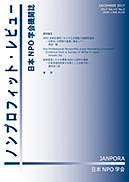Volume 16, Issue 1
Displaying 1-6 of 6 articles from this issue
- |<
- <
- 1
- >
- >|
Special Feature Nonprofit Evaluation and Assessment
-
2016Volume 16Issue 1 Pages 1-4
Published: 2016
Released on J-STAGE: July 13, 2016
Download PDF (733K) -
2016Volume 16Issue 1 Pages 5-14
Published: 2016
Released on J-STAGE: July 13, 2016
Download PDF (917K) -
2016Volume 16Issue 1 Pages 15-26
Published: 2016
Released on J-STAGE: July 13, 2016
Download PDF (944K) -
2016Volume 16Issue 1 Pages 27-37
Published: 2016
Released on J-STAGE: July 13, 2016
Download PDF (951K) -
2016Volume 16Issue 1 Pages 39-55
Published: 2016
Released on J-STAGE: July 13, 2016
Download PDF (1215K)
Research Note
-
2016Volume 16Issue 1 Pages 57-65
Published: 2016
Released on J-STAGE: July 13, 2016
Download PDF (892K)
- |<
- <
- 1
- >
- >|
